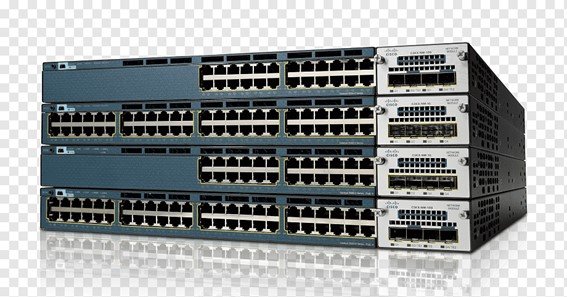Are you familiar with the term called multilayer switch? We know that there is an increase in the diversity of network applications all over the globe. These switches are growing rapidly in data centers and networks. In my article, I will share all the necessary information about these switches. I have also shared some important features of these switches. They are regarded as a technology to enhance the network routing performance in LANs. Continue reading to get a clear explanation of the multilayer switch and how to use it.
What Is A Multilayer Switch?
A multilayer switch is a network device that enables operation at multiple layers of the OSI model. They can perform the functions of a switch as well as a router at incredibly fast speeds. These switches forward the data packets based on the Layer 2 information like media access control (MAC) addresses. As this switching technology developed, more higher-level functions were added. For example, the ability to look deep inside packets for information.
Usually, an MLS has a 10gbe switch and a Gigabit Ethernet switch. By the way, the OSI has seven layers in it. This includes the Physical Layer, Data Link Layer, Network Layer, Transport Layer, Session Layer, Presentation Layer, and Application Layer. So, the MLS performs its functions mostly in the application layer i.e. Layer 7. This switch can do the context-based access control, which is the primary function of later 7. Besides, the Layer 3 switch is the most commonly used multilayer switch.
Cisco offers multiple varieties of multilayer switch models. These switches are designed according to their structure. On the lower end, there are the single rack unit (1 RU) models that are designed for wiring closets and small installations. Some of these switches can be stacked in several ways depending on the model.
click here – DIFFERENCE BETWEEN C AND C++ PROGRAMMING LANGUAGE
How To Use A Multilayer Switch?
You have to follow three main steps to configure this switch. Continue reading to know more about it.
Preparation
- To start, determine the number of VLANs that will be used, and the IP address range (subnet) of each VLAN.
- Next, identify the addresses that will be used for the default gateway and DNS server within each subnet.
- Determine if you are going to use DHCP or static addressing in each VLAN.
Configuration
You can now start the multilayer switch configuration by using the following steps.
- Enable routing on the switch with the help of an IP routing command.
- Next, you can log into the MLS management interface.
- Finally, create the VLANs in the MLS and assign ports to each VLAN.
Verification
In the end, you still need to offer a snapshot of the routing table entries. You have to list a summary of an interface’s IP information and status.
Multilayer Switch Features
Below I have mentioned down some important factors of these switches.
| Feature | Description |
| Easy to use | Usually, MLS are configured automatically. Its Layer 3 flow cache is set up automatically. You no longer need to learn new IP switching technologies for its plug-and-play design. |
| Faster Connectivity | In an MLS, you can gain the benefits of both switchings and routing on the same platform. This can meet the higher performance needed for the connectivity of intranets and multimedia applications. |
| Transparency | They require no end-system changes and no renumbering of subnets. |
| Standard Based | It uses IETF2 standard routing protocols such as OSPF and RIP for route determination. You can also deploy MLS in a multivendor network. |
| Investment Protection | You are free to use MLS with your existing framework and models. While MLS allows you to use either an integrated RSM or an external router also. |
| Resilience | This particular feature enables the switches to transparently switch over the Hot Standby backup router. It helps to eliminate network failure. |
| Access Lists | This feature allows you to set up an access list to filter or prevent traffic between members of different subnets. |
| Accounting And Traffic Management | They allow you to see data flows as they are switched for troubleshooting, traffic management, and accounting purposes. |
| Fast Convergence | It allows you to quickly respond to route failures and routing topology changes. |
| Network Design Simplification | This enables you to speed up your network while retaining the existing subnet structure. |
Multilayer Switches Examples
Below I have sorted out the best multiple switches for you.
- Cisco Catalyst 9400 Series MLS
- Cisco Catalyst 9300 Series MLS
- Cisco Catalyst 9200 Series MLS
- Cisco Catalyst 4500 Series MLS
- Cisco Catalyst 3650 Series MLS
Multilayer Switch Vs Router
However, you may find three key differences in MLS vs routers. Continue reading to know more about it.
- Firstly, MLS route packers on Application Specific Integrated Circuit (ASIC) hardware. While routers typically use software to the route.
- Another main difference is that MLS route packets faster than routers.
- Lastly, the MLS lacks some Quality of Service (QoS) features. However, routers support numerous different WAN technologies.
click here – How To Clean Silver Coins? 7 Methods To Clean Them
Multilayer Switch Vs Layer 2 Switch
In simple words, the Layer 2 switch forwards data packets based on the Layer 2 information and can inspect frames. However, these switches work exactly like the Layer 2 switches but it has a routing function as well. This includes static routing and dynamic routing.
Read Also: How To Scale Up Training In Your Organization?
FAQ
Can Multilayer Switch Replace Router?
Although both Layer 3 switches and routers have routing functions, they cannot be equated. The router not only has routing functions, but also provides additional functions of switch ports and hardware firewalls.
Why Is It Better To Use A Router Than A Multilayer Switch?
Multilayer Switch vs Router
Another difference is that multilayer switches route packets faster than routers. In addition, based on IP addresses, routers can support numerous different WAN technologies. However, multilayer switches lack some QoS (Quality of Service) features. It is commonly used in LAN environment
What Is The Main Difference Between A Layer 2 Switch And A Multilayer Switch?
The layer 2 and Layer 3 differs mainly in the routing function. A Layer 2 switch works with MAC addresses only and does not care about IP address or any items of higher layers. Layer 3 switch, or multilayer switch, can do all the job of a layer 2 switch and additional static routing and dynamic routing as well.
Why Is A Router Called A Layer 3 Switch?
A Layer 3 switch is both a switch and a router. So Layer 3 switch is a switch that can route traffic, and a router with multiple Ethernet ports has a switching functionality. It can switch packets by checking both IP addresses and MAC addresses.
Why Do We Need Multi-Layer Switches?
Multi-layer switching combines layer 2, 3 and 4 switching technologies and provides high-speed scalability with low latency. Multi-layer switching can move traffic at wire speed and also provide layer 3 routing.
Do You Need A Layer 3 Switch For Vlans?
Since VLANs exist in their own layer 3 subnet, routing will need to occur for traffic to flow in between VLANs. This is where a layer 3 switch can be utilized. A Layer 3 switch is basically a switch that can perform routing functions in addition to switching.
Is A Multilayer Switch Better Than A Router?
Multilayer Switch vs Router
Another difference is that multilayer switches route packets faster than routers. In addition, based on IP addresses, routers can support numerous different WAN technologies. However, multilayer switches lack some QoS (Quality of Service) features. It is commonly used in LAN environment.
Is A VLAN Layer 2 Or 3?
VLANs are data link layer (OSI layer 2) constructs, analogous to Internet Protocol (IP) subnets, which are network layer (OSI layer 3) constructs. In an environment employing VLANs, a one-to-one relationship often exists between VLANs and IP subnets, although it is possible to have multiple subnets on one VLAN.
Read Also: Easy and Smart Shopping Ideas for Bathroom’s Facelift
Conclusion
Thus, a multilayer switch provides high functions in networking. The MLS is the network device that forwards the data packets based on Layer 2. They inspect the deeper into the protocol description unit. In these switches, higher-level functions are also added such as the ability to look inside packets for information. Generally, they use ASIC hardware circuits to perform routing functions. In short, you can say MLS has become the device that examine Layer 2 through Layer 7. In my above article, I have explained the term multilayer switch you should know.
What is the difference between multilayer switch and router
What is a multilayer switch (MLS)?






